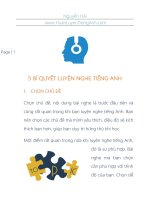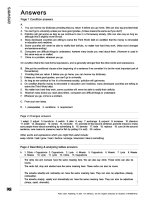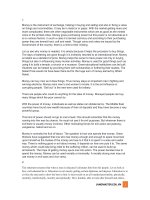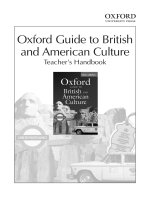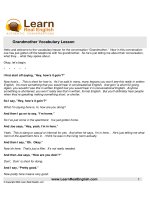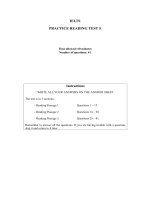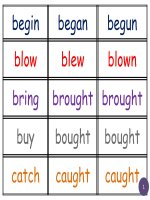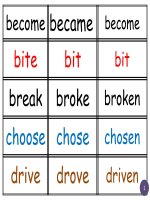Merry christmas kho tài liệu học tiếng anh
Bạn đang xem bản rút gọn của tài liệu. Xem và tải ngay bản đầy đủ của tài liệu tại đây (11.97 MB, 78 trang )
U
;l{
}N
rog
----
1
;-q
&l
**= '
---
by JennyDooley& ChrisBoles
PrimoryStogeI Teocher's
Edition
l n t r o d u c t i o n................
SuggestedLesson Plan .........
tl
Merry Ghristmas,Scene I ..............
4
Song : Ghristmas is Goming!
10
M e r r y C h r i stma s,S ce n e 2 ..............
tl
Song : lt's Christmas Time
18
M e r r y G h r i stma s,S ce n e 3 ...............
20
Song: Get Ready!
26
ilferry Ghristmas,Scene 4 ...............
28
S o n g : W e Wi sh Y o u A Me rry Gh ristm as..,............
p
34
Activities
n
36
Suggestions for Staging
Howto Stagethe Play
p
Scriptand GeneralStageDirections
Props
Scenery
SetArrangement
Costumes
DramaActivities
Word List'
|t.
p
p
P'
p.
p
p
p
p,
49
49
50
56
56
58
59
62
Introduction
Christmas-time is a series of graded readers which is aimed at young learners between the ages of
6 and 10. The series helps students to develop their knowledge of the English language through
enjoyable stories about the spirit of Christmas from all over the world. The series also provides further
practice activities in the language presented in each story. Therefore, it is suitable for use as a
supplement to most primary courses and in all teaching situations.
The books are especially designed to motivate young learners of English as a foreign language and
encourage them to take an active interest in the language. Each story can easily be turned into a play
for a class production. These plays offer parts to learners of different abilities and are therefore suitable
for all primary classes.
The series has three key levels:
Primary Stage 1
Primary Stage 2
Primary Stage 3
The stories are written in rhyme for Primary Stages 1 and 2, as learners aged 6 to 9 tend to find it
much easier and more enjoyable to read and learn language in rhyme; Primary Stage 3 has been
written in prose, as learners at this stage should be exposed to everyday speech patterns. Each story is
accompanied by a fully-dramatised recording , so that even learners who use the series outside the
classroom can benefit from exposure to the correct pronunciation and intonation of the English language.
In addition, they will gain a better understanding of the language in context.
Christmas-time Primary Stage 1 is the first stage of the series. It is designed for children between
the ages of 6 and 8 who have completed between 30 and 40 hours of English language learning.
Components:
• Pupil's Book
• Teacher's Edition
• Audio CD / Cassette
The Pupil's Book is divided into five main sections:
• The story itself is presented in double-page spreads and is accompanied by a picture dictionary
for each spread, which presents the core vocabulary used.
• Activities for further practice of the language learned throughout the story. These are clearly
indicated in the main story through child-friendly signposting.
• A song after each scene in the story related to the main topiC.
• A script and a list of props for the production of the story as a play. This will activate the students'
passive language by encouraging its use in a real situation (the staging of the play). It will also help
teachers by illustrating how the play can be staged simply and effectively.
• An alphabetical word list of all the vocabulary items presented in the picture dictionary throughout
the story. This may easily be turned into a glossary if the students are encouraged to write their first
language equivalent next to each item.
I
The Teacher's Edition includes all of the above, the only difference being that the answers in the
Activities section are over-printed for easy reference. It also includes an additional section called
Suggestions for Staging, which offers stage directions, practical tips on costuming, floor plans, a list of
props needed for each scene (as well as ideas on how to make them), and drama activities so that
learners are prepared and motivated to take part in the production.
Suggested Lesson Plan
The story can be covered in four lessons. Each lesson has a corresponding set of tasks in the Activities
section.
In the first lesson:
When first presenting the story, start by brainstorming ideas on the subject of the story by asking
questions about the title and the cover of the book. If necessary, allow students to use their mother
tongue to answer the questions.
e.g. What is the title of this story?
What can you see in this picture?
What are they doing?
What do you think this story is about? etc
In aI/lessons:
1. As an introduction to the lesson, pre-teach the core vocabulary. Then focus on the main scenes in
each spread and ask questions to help students describe the action in the pictures. e.g. Who is
this? (point to each character in tum)
What is he/she doing?
What do you think is happening here?
2. Play the recording for the whole lesson. Students follow in their books.
3. Ask students questions about the course of action in the story an9 whether it was as they expected.
4. Play the recording again, pausing at the end of each line to allow students to repeat. Repeat this
step as many times as necessary. Instruct students to do the same at home with their own recording
so as to improve their ability to read aloud as well as to practise their intonation and pronunciation.
5. Assign roles and ask students to read the story aloud in class. Repeat this step until every student
has had an opportunity to read.
6. Revise the core vocabulary which was pre-taught in step 1.
7. Point to the signpost referring students to the activity section for that lesson. Ask them to turn to
these activities in the book. Go through the activities in class, without allowing students to write the
answers. Assign them as written homework.
8. Play the song at the end of each scene and ask the class to practise singing it along with the
CD/cassette.
In the next lesson:
1. Start by singing the song taught in the previous lesson. Then ask questions to revise the story so
far. These can be answered in the students' native language.
2. Assign students a role in the story and ask everybody to read the story aloud. Demonstrating what
students have learned at home will enhance their confidence and motivate them to continue with
their learning. Make sure you always give them some positive feedback on their performance
whether it is on their pronunciation or acting.
3. Proceed to the next lesson in the story.
,
It'sChristmas * t im
atet he Nor t hPole.
It'ssno wing
o uts ideand it ' sv er yc old.
In Sa nta 's
works hop
the elvesare busy,
Butit'sCh ristmatism e.so thev'rev
hap
Hurryup!Hurryupl
Christmos
is coming!
Christmos
is coming!
e cheerl.
Everyon
I
,-4 /
snowlng
workshop
elves
Who'sof the
door?
Whoconit be?
Who'sof the door?
Openondsee!
o door
d
.*5 {
r**
ft's Peter,the
postmon!
Please
comein!
Hello,
everybody!
Hi, Peterl.
Comein!
I
, -6
r
/
o Postmon
Hereyouore!
This bog'sfor you.
It's very big!
Andheovy,too!
(
heovY
-7f
l*
-
It's fuff of lettersfrori
oround
the world.
Fromeve?ylittle boy
andgirll
Christmas
listsfor
SontoClous!
Fromollthe little
girlsondboys!
#
{
n.8
r
{
o list
letters
the world
Well,MerryChristmos,
everyonel
I hopeyouhovelotsof
'A MerryChristmos
to you,tool
Peter.
Goodbye,
Seeyousoonl
I
*9 r
r
-
ChristmosIs Coming
r
Christmos
is comingl
The goose is gettingfot.
Please
puto pennyin the oldman'shot
If you hoven'tgot o penny,
o hoff-penny
willdo.
If youhoven'tgot thot,
then Godblessyou.
,:,tlt
-77
/
The presents
are ready- it'sChristmas
Nowit'stimefor Santato leave!
Letters,letters
everywhere
from
little girlsond
f
-1 2 t
r
presents
Thechildrenosk
Sontoto sendthem
lots ondlots of toys.
children
MerryChristmos
Ho,ho,ho!
ft's neorlytimefor
ft's neorlytime,
SontoClous.
To visitolf
fhe girlsondboys
(
--t3 /
r
Lotsondlots of
lovelypresents!
They'reready,
Oh,thonkheovens!
(
r
-t4
r
A dollfor Mory,
o teddyfor John.
There'so present
here for everyone!
ffi%"o teddy
(
,- 1 5 /
r
Hoppychildren,
everywhere.
Timeto go,Sonto.
Pleasetoke core!
r
Timeto fly!
Everything's
reody,
so goodbyel
Awayyougo!
Onyoursleigh
ove?the snow!
,- 7 7 I
r
It's ChristmosTime
ft's Christmas
time!
ft's Christmos
time!
Giving-awoy-t
he-presentst ime.
Onef or youondonef or me.
Wropthemupondunderthe treel
ft's Christmos
time!
ft's Christmos
time!
Loughing-ond-s
inging-ondhoppytime.
Here'so bikeondthere'so boll.
Wropthemupandgivethemoll!_.
I
,-t8 r
r
rl|
-\
I
-19
lFt
a
Santa'sreindeer
arewaitingoutside,
They'regettingreadyto fly.
Hello,Sonto.
Here'syoursleigh!
Wefl done,reindeer
Let'sfly oway!
rt
(
r
-20
/
* ' fi
Here'sComet,
here'sCupid.
Here'sDosherond
Here'sDoncer
ondProncer.
ond
Here'sDonner
(
,*2 1 /
r
tns*
\
I
Andwhotobout
Rudof
ph2
youreodyto gol
Oneminute,Sontol
Let me mokemy
N$',
-o
///
*"
\5,.r
(
,*22 r
r
o nose
glow
We'rereodyto
go,so holdon
tight!
yournoseis so
brighttonight!
(
"*23 /
r
